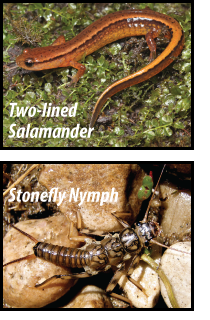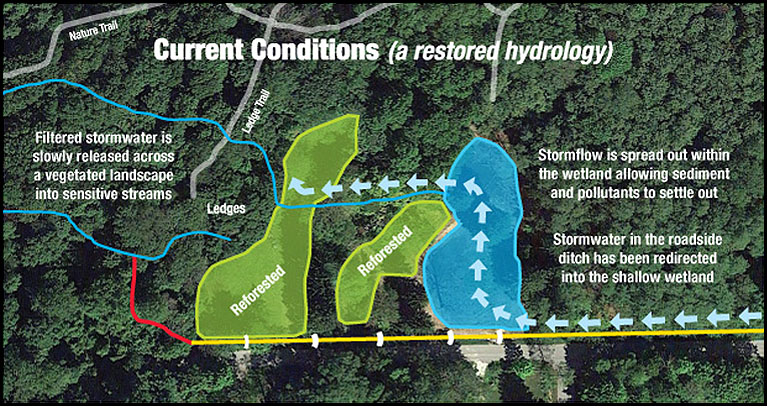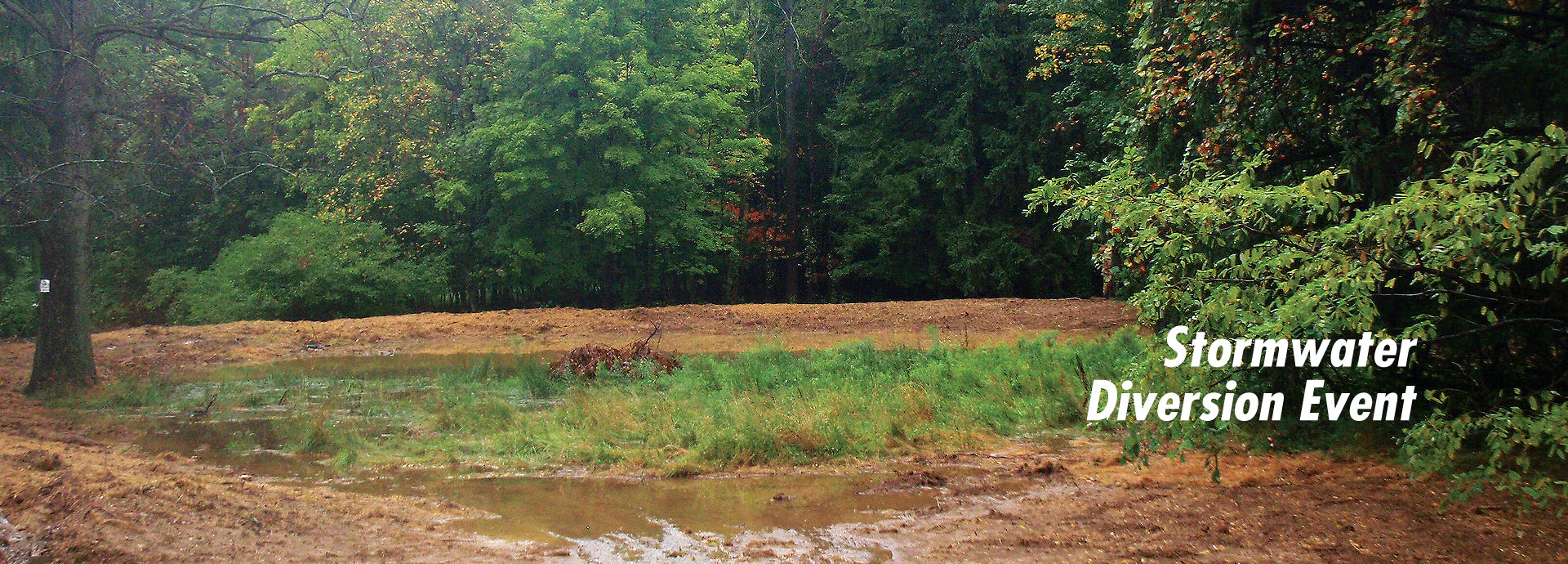Stormwater Management Project
THE PROJECT
This wetland is the result of a collaborative effort between the Rocky River Watershed Council and Medina County Park District. This project was financed, in part or totally, through a grant from the Ohio Environmental Protection Agency under the provisions of the Surface Water Improvement Fund.
 This wetland intercepts stormwater that was negatively impacting small, high-quality streams in the watershed of the West Branch Rocky River. These small streams can be seen emerging from beneath the exposed sandstone bedrock of Princess Ledges Nature Preserve. Primarily fed by cool, naturally-filtered groundwater, these streams are home to sensitive animals like stoneflies, mayflies, dragonflies, salamanders, and more. These animals live within small spaces beneath and between the rocks and rely on this complex ecosystem for their survival. In an undisturbed environment, stormwater moves slowly across the landscape and is absorbed and filtered along the way by root systems before it gathers into small headwater streams like these.
This wetland intercepts stormwater that was negatively impacting small, high-quality streams in the watershed of the West Branch Rocky River. These small streams can be seen emerging from beneath the exposed sandstone bedrock of Princess Ledges Nature Preserve. Primarily fed by cool, naturally-filtered groundwater, these streams are home to sensitive animals like stoneflies, mayflies, dragonflies, salamanders, and more. These animals live within small spaces beneath and between the rocks and rely on this complex ecosystem for their survival. In an undisturbed environment, stormwater moves slowly across the landscape and is absorbed and filtered along the way by root systems before it gathers into small headwater streams like these.
Development in the watershed upstream of these small tributaries can alter stream habitat and render it unsuitable for all but the most tolerant of species. As stormwater moves rapidly across impervious surfaces like rooftops, parking lots, roadways, and even the compacted soils beneath our shallow-rooted lawns, it carries with it pollutants in various forms. These pollutants include petroleum products, chemical cleaners, pesticides, and fertilizers to name a few; but the pollutants also include sediment from soil erosion and heat pollution as rainwater flows across hot pavement and rooftops.
In 2010, park natural resource staff noted a severe erosion problem impacting one of the small spring-fed streams beneath the sandstone ledges within the park. The issue was traced back to a roadside ditch along Elm Avenue adjacent to park land. In 2013, the park district acquired properties on the north side of Elm Avenue and began work to address the erosion problem.


 The project restored the natural pathway of water across the landscape while increasing its capacity to store and absorb storm runoff. Invasive plants were removed and replaced with native vegetation including hardwood trees planted, in part, by the hard work of park volunteers. In addition to addressing negative impacts to sensitive cold water streams, this wetland provides valuable habitat for a wide range of wildlife.
The project restored the natural pathway of water across the landscape while increasing its capacity to store and absorb storm runoff. Invasive plants were removed and replaced with native vegetation including hardwood trees planted, in part, by the hard work of park volunteers. In addition to addressing negative impacts to sensitive cold water streams, this wetland provides valuable habitat for a wide range of wildlife.
SURFACE WATER IMPROVEMENT FUND
The Surface Water Improvement Fund was created in 2008 with the passage of Ohio House Bill 119 and authorizes the Ohio Environmental Protection Agency to provide grant funding to applicants such as local governments, park districts, conservation organizations and others. Funds awarded are used to implement projects that address nonpoint source pollution and/or storm water runoff and improve water quality in Ohio’s streams, rivers and lakes.
 This publication was financed in part or totally through a grant from the Ohio Environmental Protection Agency under the provisions of the Surface Water Improvement Fund.
This publication was financed in part or totally through a grant from the Ohio Environmental Protection Agency under the provisions of the Surface Water Improvement Fund.






